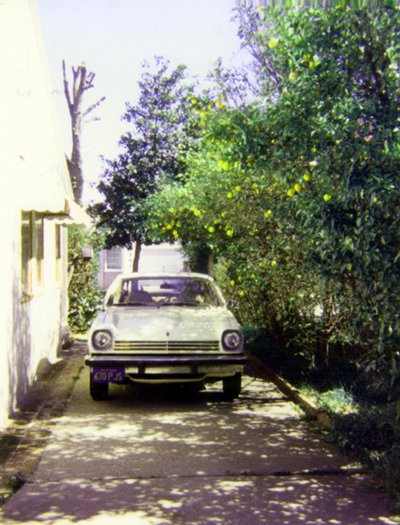Chevrolet Vega
1970-1977
A hard-luck car model
Once every ten or twelve years a hard-luck car is launched upon a sea of troubles. The Edsel in the 1950s from Ford Motor Co., the Corvair in the 1960s, and the Vega in the 1970s — both Chevrolet models from General Motors — were not as bad as their critics said they were, but were not good enough to overcome their bad publicity, some of which resulted in self-inflicted wounds.
Usually a publicity campaign (that we discount a lot but believe a little) sets us up for an announcement that a new era has arrived, and that we are fortunate that we live in these times of great automotive progress. One of the magazine ads for the Vega in 1970 showed a cartoon-type drawing of a huge automobile factory with its big door open just a little. Peeking out of the door was a tiny car, suggesting that Chevy had just had kittens and one of them was looking timidly at the great outside world. The ad got our attention, and we waited eagerly for the new little car.
 We knew that General Motors had been building small cars as far back as the 1930s. The smallest models of the German Opel and the British Vauxhall, both GM products, were very small by American standards, and after World War II Americanized versions were on the Detroit drawing boards. By the time GM got around to the Vega, Ford had the Pinto, and American Motors also had competitive sub-compact cars.
We knew that General Motors had been building small cars as far back as the 1930s. The smallest models of the German Opel and the British Vauxhall, both GM products, were very small by American standards, and after World War II Americanized versions were on the Detroit drawing boards. By the time GM got around to the Vega, Ford had the Pinto, and American Motors also had competitive sub-compact cars.
The Vega was heavier and more expensive than the Pinto and the Volkswagen Beetle. Its most significant feature was its aluminum engine block without cylinder sleeves. It had four cylinders and an overhead camshaft. Displacement was 2300 cubic centimeters, 140 cubic inches. The wheelbase was 97 inches. Front brakes were discs. It looked like a smaller and stubby Camaro, a neat design. Handling was good, and it was a good city car. Vega body styles were the usual sub-compact models: a hatchback coupe, a notchback two-door sedan, a station wagon, and a panel truck.
The Vega body was a single welded unit and the automated assembly line included robot welders. GM announced that when the plant got up to full speed, 100 cars would come down the line very hour. Of course that was one of those numbers that grab the headlines but can be misleading. The speed of assembly depends on how much of the job has been done elsewhere..
Everything combined to put the Lordstown, Ohio plant in a big goldfish bowl illuminated by the glare of publicity, both paid and unpaid. Reporters and commentators from all over the country flocked to the factory as soon as they heard about the new car, the speed of the assembly line, and the possibility of conflict. Automation was not a new idea, arguments about the speed of an assembly line were not unknown, and there wasn't much about the car itself that was revolutionary. The plant itself was not new; it was extensively converted to build the Vega.
Just as the Vega was getting started, the United Auto Workers Union struck all of General Motors for two months. There were hardly enough Vegas in the hands of dealers to provide demonstrations, and the promotion publicity had to be done all over again after the strike. Then in 1972 another strike hit the Lordstown plant. It lasted three weeks, generating more unwanted publicity. People did not get the impression that the cars were lovingly assembled by dedicated workers. I can say from personal experience that the early Vegas were not put together with great care, and Chevrolet had to extend their warranty coverage..
The cars improved as time went on, as most cars do. In 1974 the front end was changed, not an improvement. The last Vega was the 1977 model. The Vega was not a failure and not a success. Thousands of them are still running errands today.
Some hand-built, limited-edition sports cars were designed by the Cosworth Engineering Group in England and were put together by Chevrolet. There were not many stock Vega parts in the Cosworth Vega. It had two overhead camshafts, with 16 valves for the four cylinders. Electronic devices were provided to monitor and control engine functions. Suspension changes brought the handling up to the standards called for by the higher speed and much greater power. The Cosworth Vega sold for about twice the price of the regular Vega. It was sold only in 1975 and 1976.
© 1991 Wilfred R. Franson
Note: Bill Franson's brother, Don Franson, worked twenty-five years at the Chevrolet plant in Van Nuys, California. Don bought successively a Corvair, a first-year Vega (1971 model year), and later a 1976 Vega. The first Vega tended to squeal its tires as Don backed it out of his long driveway; and the brothers had trouble getting its hood open to examine the new-style aluminum engine. The later Vega was better by comparison. — RWF
Caption: "Vega & lemons (no connection)".
Transport at Troynovant
ships, trains, autos,
aircraft, spacecraft
More by Wilfred R. Franson
| Troynovant, or Renewing Troy: | New | Contents | |||
| recurrent inspiration | Recent Updates | |||
|
www.Troynovant.com |
||||
|
Essays A-L,
M-Z: mining the prismatic veins of Knowledge |
||||
| Strata | Regions | Personae |
|
|||